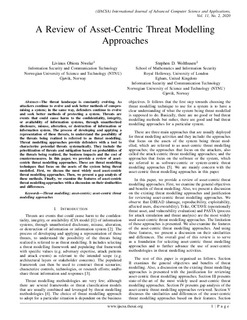| dc.contributor.author | Nweke, Livinus Obiora | |
| dc.contributor.author | Wolthusen, Stephen | |
| dc.date.accessioned | 2020-03-17T14:24:29Z | |
| dc.date.available | 2020-03-17T14:24:29Z | |
| dc.date.created | 2020-03-02T08:20:24Z | |
| dc.date.issued | 2020 | |
| dc.identifier.citation | International Journal of Advanced Computer Science and Applications (IJACSA). 2020, 11 (2), 1-6. | nb_NO |
| dc.identifier.issn | 2158-107X | |
| dc.identifier.uri | http://hdl.handle.net/11250/2647234 | |
| dc.description.abstract | Abstract: The threat landscape is constantly evolving. As attackers continue to evolve and seek better methods of compro-mising a system; in the same way, defenders continue to evolve and seek better methods of protecting a system. Threats are events that could cause harm to the confidentiality, integrity, or availability of information systems, through unauthorized disclosure, misuse, alteration, or destruction of information or information system. The process of developing and applying a representation of those threats, to understand the possibility of the threats being realized is referred to as threat modelling. Threat modelling approaches provide defenders with a tool to characterize potential threats systematically. They include the prioritization of threats and mitigation based on probabilities of the threats being realized, the business impacts and the cost of countermeasures. In this paper, we provide a review of asset-centric threat modelling approaches. These are threat modelling techniques that focus on the assets of the system being threat modelled. First, we discuss the most widely used asset-centric threat modelling approaches. Then, we present a gap analysis of these methods. Finally, we examine the features of asset-centric threat modelling approaches with a discussion on their similarities and differences. | nb_NO |
| dc.language.iso | eng | nb_NO |
| dc.publisher | SAI Organization | nb_NO |
| dc.rights | Navngivelse 4.0 Internasjonal | * |
| dc.rights.uri | http://creativecommons.org/licenses/by/4.0/deed.no | * |
| dc.title | A Review of Asset-Centric Threat Modelling Approaches | nb_NO |
| dc.type | Journal article | nb_NO |
| dc.type | Peer reviewed | nb_NO |
| dc.description.version | publishedVersion | nb_NO |
| dc.source.pagenumber | 1-6 | nb_NO |
| dc.source.volume | 11 | nb_NO |
| dc.source.journal | International Journal of Advanced Computer Science and Applications (IJACSA) | nb_NO |
| dc.source.issue | 2 | nb_NO |
| dc.identifier.doi | http://dx.doi.org/10.14569/IJACSA.2020.0110201 | |
| dc.identifier.cristin | 1798795 | |
| dc.description.localcode | This is an open access article licensed under a Creative Commons Attribution 4.0 International License, which permits unrestricted use, distribution, and reproduction in any medium, even commercially as long as the original work is properly cited. | nb_NO |
| cristin.unitcode | 194,63,30,0 | |
| cristin.unitname | Institutt for informasjonssikkerhet og kommunikasjonsteknologi | |
| cristin.ispublished | true | |
| cristin.fulltext | postprint | |
| cristin.qualitycode | 1 | |

